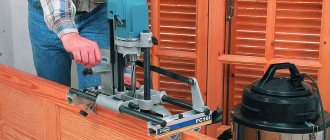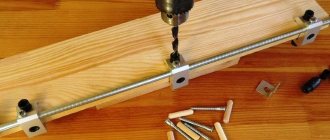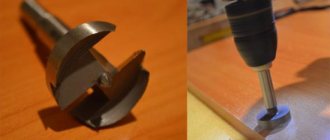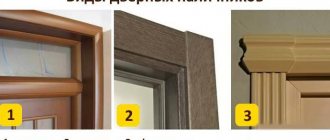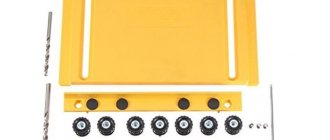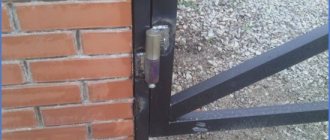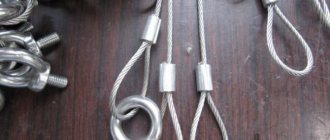A couple of decades ago, door installers struggled without templates for cutting in door locks and hinges. They cut it out with chisels and a milling cutter. For a long time - more than an hour, all two or three. Depends on the experience of the master. Trying not to make it crooked or sloppy, so that it looks decent. There were no other options.
- More doors appeared. The quality of the material is low - it crumbles with any manipulation. In another case, the door is expensive, you are afraid of damaging it. Clients understand the difference between good work and bad work. They know how it should be.
- New methods and tools for installing fittings have appeared, and it has become impossible to work with the old ones. Without a professional conductor for a router for hinges and locks, amateurs now work using the methods we inherited from our grandfathers.
- Over the past 20 years, a large selection of instruments has appeared on the market. Now you don’t have to suffer yourself, but make the work easier and faster - buy a template for inserting hinges and locks. Let's look at the most popular options.
The essence of the technique
Instead of hollowing out a groove in the wood with a hammer and chisel after marking the loop, we resort to another method. Using a finger cutter , we will make these indentations much faster and more beautiful.
@youtube.com, channel Repairman School
Please note: it is better to make a socket for a mortise lock using a feather drill, without making a face or reconfiguring the router. Next I will describe this technique.
Marking for loops
I will not describe the making of templates for marking, since the hinges on different doors may differ in size and geometry. Therefore, we do this: we measure from the upper end of the fabric from the loop side down along the standing side one and a half times the size of the loop . Let's say, if the loop has a size of 120 mm, we retreat 180, and do the same with the lower canopy.
If there are three hinges (and this also happens when the door is quite massive), then the third canopy is placed according to the same pattern. It should be located at the top one and a half sizes from the top overhang, and not in the middle of the height of the door. Master this simple diagram so you don’t get confused with sizes and distances in the future.
@youtube.com, channel Repairman School
The markings on the door frame are done like this. After it has been assembled in rough form, it is placed on a level place. Place the door leaf in it so that the gap at the top is about 2-3, and at the bottom - 7-8 millimeters , since the door tends to sag slightly on the hinges. This rule is especially relevant if the box has a threshold. On the sides, the gap between the canvas and the box should ideally be five millimeters on both the lock and hinge sides. Outline the position of the hinges on the end of the box (with the door inserted into it).
After the marking has been applied with a pencil, I strongly recommend that you lightly walk along its contour with a chisel . This will greatly simplify the task during subsequent sampling. Pay special attention to areas where the chisel is located across the grain of the wood (if wooden doors are hung).
@youtube.com, channel Repairman School
Attention! Don’t hesitate to fit the door into the dimensions of the frame! This advice is especially relevant if the door suddenly turns out to be not perfectly rectangular. It happens, take my word for it.
Preparing to cut in canopies
Cutting canopies with a router
This procedure is the most common and is used both when replacing an old door and when installing a new one. In addition to the cutter, you will also need an ordinary carpenter's ruler, as can be seen in the video.
At the first stage, it is necessary to mark the frame for the existing hinges of the interior door so that the adjustment takes place quickly and correctly. The position of the hinges should be adjusted taking into account the least likely distortions when opening/closing the door. Marking can also be done using a special template that you can make yourself. Sometimes an unnecessary fragment of door molding, the dimensions of which coincide with the dimensions of the door frame, is also adapted to the template.
First, one of the edges should be trimmed. The marked square is installed on the outer sides of the door and strips of adhesive tape are glued in the necessary places - they will serve as a kind of limiter for the movement of the router.
Recess for the locking part
Before embedding the lock into the interior door, mark the selected height on the door. Make this more convenient using a tape measure. We place a mark at the end and transfer it using a square or building level to both sides of the door leaf.
- Take the lock/latch and apply it to the end of the door so that the middle of the lock falls on the drawn line. We mark the width of the metal locking part and the level at which the lining ends.
- We take a 16 mm feather drill and apply it to the part of the lock that will be inserted into the door leaf. Using a marker or masking tape, or a piece of electrical tape, make a mark on the drill. This mark should be slightly further than the lock. We will use it to guide us to what depth to make the holes. This is especially important if the lock is installed against glass. Otherwise, you may drill too deep and damage the glass.
We put a mark on the feather drill - this way we will control the drilling depth - Having installed a feather drill, we make several holes one under the other, forming a recess for the lock. The number of holes depends on the size of the lock. In some models 4-6 are enough, in others you will need 8-10.
- The edges of the holes were uneven, and the wood had lifted in places. We take a chisel and remove the protruding wood fibers from the edges, working lightly and in depth (but don’t get too carried away).
The edges turned out uneven, remove the protruding fibers using a chisel - We take a regular 16 mm drill and put it in the drill. Use it to align the edges of the hole made. To do this, move it up and down, pressing lightly on one side or the other of the notch. This operation is needed to speed up the process, but the drill must be strictly controlled. If you are unsure, it is better to level the notch using a chisel and mallet.
Leveling faster with a drill - Insert the lock into the resulting hole. It is usually a little larger, so there are no problems. If necessary, using a chisel or drill it can be increased to the desired size.
- We set the lock to the desired position and attach it to the door leaf using two self-tapping screws (one at the top, the other at the bottom).
How to embed a lock into an interior door: modifying the recess - Using a pencil or a utility knife, trace the perimeter of the lock lining. We remove the lock, take a chisel and remove 1-2 mm of wood, MDF or veneer inside the markings made.
Don't miss: Replacing glass in an interior door: repairing broken glass, how to insert or change it yourself
The depth of the recess for the locking part depends on the thickness of the decorative strip. Usually they try to make sure that the strip is flush with the end of the door, but it may protrude a little. Shoot little by little as you work—it’s easier to edit it than to try to restore what you shot.
We put the handles
To finish installing the lock on the interior door, you need to make holes for installing handles. The work is much less than what has already been done, but accuracy is required. Mistakes are not too critical, although it is better to try to avoid them.
The handles come complete with self-tapping screws for wooden doors and tie bolts for installation in a metal door. It is better to replace the self-tapping screws from the kit - they are usually made of soft metal. Unless you bought a branded foreign lock, in which the screws are hardened. And so, buy several good screws with a diameter of 1.5-2 mm and a length of about 1 cm.
- We take the lock and apply it to the side surface of the door, matching the height.
- Using a pencil, marker or awl, we make marks through the slots for installing handles.
We make marks on both sides of the door - We repeat the operation on the other side of the door leaf.
- We install a crown or a feather drill of a suitable diameter on the drill. Place the center of the drill/bit at the marks and make holes. An important point: we do not drill through, but from both sides, towards each other. That is, as soon as the drill falls into the recess made for the lock, we stop the work and start from the other side.
- We remove the shavings from the recess for the lock, put the lock plate in place, and secure it with self-tapping screws.
- We loosen the clamping screws on the handles - the central rod should “move” freely, and install it in place.
We install and secure the handles - Align and fasten with self-tapping screws. It is better to pre-drill holes in veneered doors.
- You just need to tighten the fastening screw that connects the two handles and the lock cylinder. They are usually located on the underside of the handle. Take a screwdriver and tighten the screws on both handles.
Installing decorative trims
Some models have decorative overlays. We align them using a square.
Installing the lock latch
Locks for interior doors usually have a rotating latch on one side that locks the lock, and on the other side there is only a lining with a slot. That is, you can’t just open the door from the outside—you need a special key. Installing this part of the lock takes literally a couple of minutes, but there are some nuances.
- We take the central part, which is inserted into the lock. We insert the side where there is no slot into the cover without a handle, insert this structure into the lower hole from the outside.
How to embed a lock into an interior door: installing a lock retainer - From the side of the room, we put a cover with a wrap on the pin.
- Tighten the clamping screw (before securing it with self-tapping screws).
- We fasten with self-tapping screws, if provided for by the design, and install decorative overlays.
That's it, inserting the lock into the interior door is almost finished, all that remains is to check the work.
Mate insert
The counter part must be installed clearly so that the doors do not play and there are no problems with closing. Therefore, we try to mark as accurately as possible and take a sharpened pencil.
- We close the doors so that the latch tongue rests against the jamb. Mark the position of the latch with a pencil (top and bottom).
- Using a triangle, we draw horizontal lines along the marks.
- We measure the exact distance from the edge of the door leaf to the middle of the lock. The middle of the lock is the middle of the tongue or the center of the fastening hole.
The middle of the castle is easy to find - On the lines marking the position of the tongue, we mark the measured distance (we measure it from the bar against which the door leaf rests). Draw a straight line through these two points. This is the marking for installing the lock mate.
- We take a 14 mm drill or a feather and drill a hole in the jamb according to the given marks. The depth of the hole is slightly greater than the length of the tongue.
- Use a chisel to straighten the hole.
We check the holes according to the marks and refine it with a chisel. - We close the doors, checking whether the tongue fits normally. If you pull the closed door towards you, there should be a small gap - a couple of millimeters - for installing the adjusting tongue on the trim. If necessary, adjust the hole.
- We put the strike plate in place and screw it on.
- We close the doors and check for play. If there is one, we remove this play using the adjusting tongue. Near this tab there is a slot for a screwdriver. We insert a screwdriver into this hole and press it a little. We close the doors and check. Repeat until the backlash disappears.
Removing the backlash of a closed door
You know everything about how to fit a lock into an interior door. The description takes up a lot of space, the process itself takes 25-30 minutes if you’re doing it for the first time. It will take more time if you level the holes with a chisel rather than with a drill. But the total duration will still not be more than an hour.
Sources
- https://stroy-podskazka.ru/freza/dlya-vrezki-zamkov/
- https://mobilspecstroy.ru/mebel/podbiraem-instrumenty-dlya-vrezki-zamkov-v-mezhkomnatnye-dveri
- https://molotokmarket.ru/stati-instrumentah/kak-vybrat-frezer/
- https://www.stroyportal.ru/articles/article-obzor-shablonov-dlya-vrezki-petel-i-zamkov-v-mezhk-11272/
- https://stroychik.ru/dveri/ustanovka-zamka-v-mezhkomnatnuyu-dver
- https://BurForum.ru/elektrooborudovanie/frezy-dlya-vrezki-petel-i-zamkov.html
[collapse]
Post Views: 5,032
Lock markings
Immediately estimate the height at which it would be convenient for you to place the door handle. For some it is better to take 80 centimeters from the bottom of the door leaf, for others it is better to raise it to a meter. a handle height of about 90 cm is usually comfortable . This is where we start when marking.
We place the mortise lock on the door frame so that its bar is flush with the end of the door. Mark with a pencil the point where the handle will be located.
@youtube.com, channel DIY apartment renovation (Remontkv.pro)
Next, insert the door leaf into the latches with the lock side up. We apply the strip to the end, outline it, making sure that it is attached to the door evenly, without distortions. After this, use a chisel to carefully knock out the outline around the perimeter of the marking. To clearly determine the seat for the lock, I advise you to make auxiliary vertical markings on the lock end of the door , finding the middle of its thickness, as a rule, this is 16-20 millimeters . It will come in handy when drilling a socket with a feather drill.
How to install a lock using a template?
How to use cutters for lining at home
Installing a lock using a template follows a similar pattern, only the recess at the end of the door is made larger. The process consists of the following steps:
- The sash is securely fixed to the floor with its side facing up. Use a pencil to mark the future insert. The lock body is applied to the end of the door and outlined.
- A template is set according to the markings. Adjust the coincidence of the matrix boundaries with the drawn lines.
- The wood is sampled using a milling cutter. If there is no tool, holes are drilled with a drill, and the remaining jumpers are cut out with a chisel. The depth of the opening must correspond to the length of the lock body.
- The template is removed from the door. The lock is applied to the front part of the sash, the holes for the handle and the keyhole are marked. Holes are made with feather drills. The lock is inserted into the cut-out recess and secured with self-tapping screws.
- The sash is hung with hinges on the frame. When closed, mark the location of the strike plate. A template is fixed to the bowl, the window is adjusted according to the markings, and a recess is selected using a router or chisel.
- The insertion is completed by fastening the strike plate with self-tapping screws and checking the functionality of the lock.
A homemade device for inserting fittings can be assembled according to individual sizes, come up with your own convenient design, and improve the clamps.
Hinge sockets
Let’s make a reservation right away: I assume that the reader has worked at least a little with a hand router and at least knows how to turn it on, adjust the speed and raise/lower the cutter. So, we take an unnecessary block, adjust the output of the cutter to the depth of the loop from the router support and try to select a small fragment from it. We make the fragment size such that it is possible to measure the depth of recessing of the loop. Guide the router in the direction of rotation of the cutter - this makes it much easier to work.
@youtube.com, channel Repairman School
We tried it on, figured it out - let's get down to business. Having made sure that the canvas placed in the clamps with the loop side up does not dangle, we select the mounting socket for the loop using the markings. Then we try it on so that it fits the dimensions and is completely recessed into the mass of the canvas.
Advice: if you don’t have enough experience, make a couple of test canopies, all on the same unnecessary block. This is a very worthwhile investment of your time and effort.
When hanging on a box, instead of a block, take the scrap formed during its assembly. The fact is that the selected quarter on the box, or, as it is also called, the fold, will not allow you to place the router platform directly on the plane where the hinge will be located. The milling cutter will have to be reconfigured. You’ll see exactly how when you start twisting a piece of the box in your hands.
I recommend: in order not to reconfigure the router several times, first hang hinges on all door leaves (if there are several of them), then start fiddling with the boxes .
How to cut a hole with a hand router
Place the template along the markings and secure with a clamp. Place the milling machine in the work area, move the tool “head” down until the cutter contacts the surface and clamp the lock lever.
By rotating the wheel, lower the depth stop until it stops at the bottom step of the position support.
Read the desired routing depth on the scale and tighten the thumb stop.
Release the lock and lift the tool body. By turning the turret support, set the depth of the first pass.
Start the hand router, after gaining speed, press the body all the way and lock the position. Cut the material by moving the tool smoothly along the plane being processed, first around the circumference and then in the center. Having completed the passage, remove the raised side with sandpaper if there is fiberboard on the surface.
Release the router body and set the next cutting depth.
Repeat the operations until the hole is completely removed.
If there is no sawdust removal system, use a vacuum cleaner to clean the work area, eliminating milling defects.
Castle part
First of all, you need to select and prepare a feather drill. The diameter should be 2-4 mm larger than the thickness of the embedded part of the lock. It’s better to give a larger margin: it’s difficult to ideally hold the drill perpendicular to the end of the door; there will probably be a small error due to the fact that the drill may twitch slightly along different fibers . To ensure that the hole does not turn out to be too small, or, conversely, too deep, we wrap the perk with electrical tape at a level slightly larger than the dimensions of the recessed part. Markers and pencils are not very suitable for marking as they wear out quickly.
@youtube.com, channel DIY apartment renovation (Remontkv.pro)
After the nest is ready, we are not in a hurry to choose a recess for the cover. Firstly, we check whether the lock fits into the socket , and secondly, we set up the router on the block. And only then we select the recess.
The hole for the handle is drilled last. And then after we once again assessed the lock against the main frame and made sure that we had not made a mistake with the preliminary markings. Again, take a drill with a diameter of 12-16 millimeters - the handle will block the hole, and no one has canceled the error in measurements.
A common mistake is that the mating part of the lock on the frame is marked until the door is already installed and the mounting foam has dried. Don't do this! The answer will take its position only after installation, so do not try to calculate or guess it. There is no need to rush here, otherwise, most likely, you will have to interrupt it in place - for some reason the lock tongue will not fall into the slot intended for it.
Source
Instructions for installing hinges in interior doors with your own hands
Author of the article: Alexandra Ivanova March 18, 2021
Door hinges are an important element of an interior door, on which its functional purpose and correct opening/closing depend. The most popular are mortise hinges. By following the instructions and recommendations of experienced craftsmen, you can install them yourself.
Drilling holes with a manual wood router - master class
Instructions and video on how to install an interior door with your own hands
Neat holes with walls strictly perpendicular to the surface are a task that can be easily accomplished using a hand router. Let's look at the technology for drilling professional-quality holes using an inexpensive groove cutter, copying bushings and a simple device - a homemade template.
Features of working with different types
Installation differs depending on the type of fittings. Types of mortise hinges :
Detachable hinges are easier to install, since the two parts are installed separately, after which the door is hung. This type is used when you have to frequently remove the interior door, for example, when moving furniture. Divided into left and right. When purchasing them, you must take this point into account. Detachable hinges require clear markings, without the slightest errors.
It is more difficult to install a universal hinge, since the hinge is fixed to the box after the second part is secured to the canvas. Therefore, the door must be held in weight or use stops. This type is one-piece. If you need to remove the door, you will have to unscrew the hinge.
According to the installation method, mortise hinges also include hidden hinges. It can be difficult for a non-professional to install them, because the body with a hinge is placed inside the canvas. Using a router, a deep seat is made. Installation requires extreme precision.
Tools for insertion and how to work with them
To insert hinges into an interior door, the following tools are required::
Professionals prefer to use templates and a milling machine. This equipment makes the work easier, and the result is an even selection for the loop map.
Many masters use Pavel Soldatov's template . The procedure for setting it up:
A plunge router is used to cut the hinges.
If you don't have a template, you can do without it. In this case, the location of the loops is marked, outlined with a sharp pencil and cut with a knife.
It is preferable to use a small router bit, in which case you will need to cut less material by hand in the corners of the recess.
Work progress :
After installing the card on the canvas, move on to the box. The location of the loops is transferred to it. To do this, the canvas is combined with a loop beam, taking into account the upper gap of 3 mm. A mark is made. Having attached a loop to it, circle it around the perimeter and cut it with a knife. If the stand is flat, without a protrusion, then there will be no difficulties when working with a router. The sampling is done in the same way as on the canvas.
If there is a protrusion (thrust quarter) on the hinge beam, then it will interfere with the operation of the router ; the sole will lie on the plane with only one side. In this case, some wizards offer the following method:
Calculation principle
For example, there is a 16 mm straight cutter and a 30 mm diameter copy sleeve. It is required to make vertical holes for round bench stops with a diameter of 21 mm. Substituting the values into the formula, we find the size of the circle cut out in the template:
D = 21 + 30 – 16 = 35 (mm).
Mark the plywood and make a hole with a drill bit of the appropriate diameter.
Sand the edges and surfaces with sandpaper.
Use one piece of plywood for several templates at once. Just don’t forget to label the holes, indicating the caliber of the cutter used and the diameter of the circle being cut.
Manual method
If you don’t have a milling machine, you can cut in the hinges manually by making a cut using a chisel and hammer.
Marking
The location of the upper and lower hinges is marked on the door leaf.
To do this, use a tape measure or ruler to measure 20 cm from the top and bottom edges. To avoid mistakes, craftsmen draw an arrow indicating where the loop will be directed from the mark. The arrows are directed towards the center of the door end. Place the loop map against the mark and trace its outline with a sharpened pencil. The hinge part must not touch the door leaf.
It is not recommended to simply measure the length and width of the card and draw a rectangle with this data on the end, since the card may not have a strictly rectangular shape - it may be beveled or trapezoidal.
The loop will fit perfectly into the groove made along the contour. In order not to confuse the loops during installation, they are signed with a marker B (top) and H (bottom).
Inset
The hinges are cut in stages:
Installation
Having screwed one part of the hinge to the door leaf with self-tapping screws, proceed to inserting the other part into the hinge beam. Different masters carry out this stage in different ways.
What kind of device is this?
The essence of this simple device is simple. It has the shape required for inserting fittings into the door body. This applies to mortise parts of structures such as hinges and locks. Using this device, it is possible to make recesses in the body of the canvas without any problems.
Attention! Such devices are designed to increase the speed of installation of fittings, and therefore are used in the production of door structures. The prices for such devices are considerable.
To insert a hinge or lock once, there is no need to buy a special template and a router for inserting locks. Because it won't pay off. If you doubt your ability to install mortise parts, contact a specialist.
If you install doors yourself, then such a tool will clearly serve you well. You don’t have to buy a factory-made product in a store, but make it yourself. This way you will save money and get a completely identical product.
Choosing a tool
Let's start by choosing a suitable router. Today, models are produced that have different purposes and, accordingly, bear different names:
In general, if you need a router for inserting hinges, both the first and the third model will do. But keep in mind here that submersible models are highly specialized. At the same time, combined ones are more likely to be considered professional. Having more weight, they are more difficult to set up.
If you do not have experience working with routers, then it is better to use a regular plunge router
Therefore, if you do not have experience working with milling cutters, it is better to give preference to a standard submersible one - there will probably not be any problems.
Main settings
Once you have decided what type of router you will use, it is also a good idea to decide on a specific model. Each of them has a number of important factors.
One of them is power. Everything is quite simple here. The higher the power, the larger the layer the cutter can immediately remove. Therefore, experienced professionals usually buy powerful milling cutters in order to quickly cope with a large amount of work. But for a home craftsman, a tool with medium power is better suited. After all, you have to pay for power - such models cost much more, and even have more weight. Often, beginners, when they pick up a powerful router, simply cannot handle it and damage the work surface. Therefore, there is no point in chasing high power.
It is also worth paying attention to the presence of a speed control function. And here it is advisable not to save money - take a model with this function. Thanks to this, it will be possible to select the optimal speed mode for performing any job. Select a high speed for roughing and a slower speed for fine finishing. Then the result of the work will be more accurate.
Some models have a backlight function. This is not a waste of money at all - if you work in low light conditions, it can be difficult to get the job done really smoothly. Therefore, it is definitely worth investing in a tool with such a function.
A backlit router is often needed when working in low light
The remaining functions (unless you are a professional choosing a universal tool) can be considered unnecessary, increasing the cost of the router and the complexity of working with it.
Finally, it wouldn’t hurt to simply hold the router in your hands, weigh it, estimate how ergonomic its handles are, and whether it will be convenient to work with. Be sure to make sure that the model you choose is not too heavy for you. Otherwise, when using the tool, you will not concentrate so much on the work as on not dropping the router.
Setting up the router before work
In many ways, the ease and quality of work depends on how correctly the router for door hinges is configured. So, before you start cutting the grooves for the door hinges, you need to do certain things. The most important thing here is the depth to which the cutter will cut into the surface being processed. It depends on the thickness of the hinges that will be installed on the door. Therefore, it is advisable to already have them on hand in order to be able to correctly configure the router.
All work can be done in several stages:
As you can see, there is nothing complicated here - every beginner can cope with this work.
Installing hinges with a router
To carry out the work, the home craftsman will only need the hinge router itself, as well as a pencil, felt-tip pen or office cutter - any tool that allows you to leave marks on a wooden surface will do. However, if you do not have jewelry precision, then it would not be a bad idea to stock up on a well-sharpened chisel and a small hammer.
Before starting, be sure to mark the loops with a pencil or felt-tip pen
The entire process of making grooves with a milling cutter occurs as follows:
At this point, the work can be considered complete - all that remains is to insert the hinges into the prepared grooves and securely fix them with self-tapping screws.
The article was prepared with the information support of the Multicut company https://www.multicut.ru/catalog/frezery/ milling and engraving machines from the manufacturer.
Source
Inset
The hinges are cut in stages:
- Use a sharp knife to cut the outline. If the coating is laminate, then it is removed with a chisel inside the cut out contour. It turns out to be a small step. Then, when working with a chisel, the tool will not come off; it will be buried and rest against the step.
- If veneer is glued, then it is carefully removed from the area under the hinge. If you do not cut through it first, then when working with a chisel, you can unwittingly damage the veneer in adjacent areas and accidentally tear it off.
- In order to find out the depth of the future groove, place the loop card sideways to the end and draw a line with a pencil, noting the thickness. It is to the thickness of the metal that the recess will need to be made.
- The chisel is placed against the edge of the recess, resting it on the “step”. In this case, the short side of the working part is directed towards the material being produced. By hitting with a hammer, the material is sampled to the required depth.
- After making the sample, attach a map and use an awl to mark the locations of the screws. In this case, the center is slightly shifted in the direction opposite to the loop cylinder. Later, the screw with its head will move the loop towards this edge and the loop will fit most tightly.
- Use a thin drill to drill holes for the screws. It is not recommended to screw them directly into the door, as the door leaf may split.
- When placing a hinge in a gap, many craftsmen advise not to bury the card flush, but to leave a protrusion of the card of about 0.5 mm. This is done so that the door can be adjusted during installation by recessing the hinge a little deeper and leveling the gaps.
Top rating templates for inserting hinges and locks into interior doors
Door hinge installers need to have a set of good construction equipment. Along with the usual set, they use a template for inserting hinges and locks. A milling device is needed when installing door hardware.
Why do you need a template for a router?
To buy a template for inserting hinges and locks, you need to study their types and operating features. In fact, there are only two types of them.
Below we describe in detail the pros and cons of each tool for installing hinges and locks. Based on the professional opinion of installers of interior doors, we will draw the right conclusions and reveal the whole truth about templates for inserting locks and hinges.
What template do professional craftsmen choose for inserting hinges and locks?
Qualified installers meticulously select the right tools from the variety offered. They know that the slightest mistake will ruin expensive doors and they will have to pay for them.
Carriage for the UVK-Profi router.
The market leader among templates for inserting hinges and locks. Surpasses similar construction equipment in cost, service life, convenience and functionality. Produced by the domestic company Master Profi, which produces professional and amateur tools for inserting fittings into interior doors. They know what is needed for precision when installing fittings.
Material used in the production of ufk-porfi: processed duralumin, structural textolite, polyacetal, capralon, hardened 16 mm stainless steel shafts are used to move the matrix, the vice is made of 8 mm steel shafts. using trapezoidal thread.
Linear bearings are enlarged, closed type, made in Germany. Plastics and other fragile materials are not used in the tool for installing hinges and ufk-pro locks.
This tool is capable of installing any fittings, even those that have just appeared on the market. The work with it is so precise that it seems as if the fittings were installed at the factory.
Advantages of the ufk profi fitting template:
Built-in template vise, designed with two independent elements, support and clamping vise are adjustable independently of each other. This makes it possible:
The UVK-Profi universal carriage for inserting hinges is worth buying because it is recommended by all experienced specialists. They always use the best tools in their work.
Numerous positive reviews indicate that the UVK-Profi tool for installing locks and hinges has established itself as the best universal template, which has no analogues in the quality of insertion, ease of use and reliability. Customers note that door hardware is installed in a matter of minutes.
Compared to similar tools, the UVK-Profi carriage is much cheaper, but it is lighter, more functional and more convenient to use.
Website of the official manufacturer where you can buy a template for inserting hinges and locks: https://master-profy.ru/ Address: M.O. Balashikha microdistrict Kuchino st. South house 9. Opening hours: Weekdays from 10:00 to 20:00, weekends from 12:00 to 18:00.
Video review and instructions for working with the tool. Information taken from the official source of the manufacturer:
Virutex hinge template
One of the analogues with a factory insert. Unfortunately, it has a number of negative aspects:
In general, there are positive reviews. The result is a high-quality and even insert.
Template for inserting Gidmaster locks
Compared to the previous model, this jig for inserting locks is a fairly cheap option (around 12,000 rubles). But it is far from universal and is only useful when working with locks. Yes, and the insertion is only possible with a drill.
Before purchasing this model, it is important to consider that:
Templates for a router with inserts and copy sleeves
Templates for inserting hinges and locks with replaceable inserts are more suitable for amateur use. But the work will take a lot of time, because there are many configurations and sizes.
In this case, you will have to spend much more money than planned. Purchasing a minimum set that is suitable only for 5 types of hinges, locks, hidden hinges, latches and strike plates will cost 15,000 rubles. For a standard set in which you can embed 30% of the existing fittings, you will have to pay at least 25,000 rubles.
Today, the complete package of inserts includes over 200 pieces. The cost of each insert is 300-500 rubles. not counting the price of the base itself for inserts and copying sleeves, all this pleasure is estimated at over 65,000 thousand rubles.
The high cost of a kit with which you can work is not the main problem with templates for an insert-based router.
Insert templates have their disadvantages:
The number of required inserts is updated every month. Old inserts for fittings that are no longer in demand will need to be constantly updated and new ones purchased. In some video reviews, door installers said that they had 300 pieces. inserts with a total weight of 40 kg. And every year there are more and more of them.
Conductor for inserting locks Gidmaster pitfalls
Attracts with its affordable price compared to Virutex. From 10 to 12 thousand rubles. However, the conductor is not universal. Used only as a template for inserting locks.
Moreover, all work will have to be done with a drill. It is extremely inconvenient, the speed is too low, you can damage the door - you often end up with chips and torn edges on the door. Especially if it is covered with enamel.
- An obvious drawback is that it is difficult to set the size correctly.
- Works only with cutters with threads on the collet.
- It is impossible to embed hinges, strikers and crossbars.

